As deer season swings into high gear, here are some tips to help you find your trophy buck this year.
Staging-Area Bucks: Bucks, particularly big ones, avoid open areas most times and are particularly shy about leaving cover during hunting season. However, food sources are where does congregate. And does are mighty attractive to a big buck this time of year. If a field is where he must go to find female companionship, then so be it—but he probably won’t come out until after dark.
So where is Mr. Buck in the waning hours of shooting light? He’s hanging out in the woods adjacent to the field edge. Look for thick patches of cover in open woods near fields. Often these “staging areas” are easily identifiable by abundant buck sign such as rubs and scrapes. If such areas also show trails converging from heavy cover, brushy ravines or such, you may have discovered Mr. Big’s “happy-hour” hangout.
Hunting The Scrapes: Scrapes are made by bucks to attract does. The buck paws out an oval or circular area and urinates in it, letting the urine flow over the tarsal glands on his legs. He also usually marks an overhanging twig with scent from his mouth and forehead. A passing doe, coming into estrus, will also urinate in the scrape. When the buck returns to check, he will pick up her scent and try to track her down.
All scrapes are not equal. Sometimes bucks make spontaneous scrapes that are seldom if ever visited again. Once things get serious, the buck lays out his scrapes in a pattern and checks them regularly. Often, he checks them by scent alone, passing downwind of the scrapes without actually going to them.
When hunting scrape lines, I position myself downwind of them rather than right over them. If I find a rub line paralleling the scrapes on the downwind side, so much the better. This rub line is the buck’s normal path while checking his scrapes.
Making The Right Calls: Successfully calling deer is based on the deer’s natural curiosity about other deer in its immediate area. However, deer are more curious at some times than at others. Does with fawns, particularly in groups, are in their mothering mode and will often respond quickly to a fawn’s distress bleat. Often it will be the dominant doe of the group that will rush right over to investigate.
During the pre-rut, bucks are becoming hostile and territorial. During this period, they are prone to investigate the grunt of a strange buck in their area. During the rut itself, a buck tending a doe is hard to pull off the scent, but a strong challenging grunt may make him want to protect both his territory and the doe. Bucks that aren’t with does are very vulnerable to doe bleats during the rut. During the post-rut, bucks are once again highly competitive over any still-receptive does. Buck grunts and doe bleats continue to be very effective.
Monsters Of Mid-Day: The first hour of dawn and the last hour of dusk are magical and highly productive times to deer hunt. Whitetail deer prefer low-light periods around sunrise and sunset. However, under some conditions, hunting in the middle of the day or all day long can be very effective.
Deer move or feed several times over a 24-hour period. Under a full moon, deer are active during the middle of the night. This may stimulate a corresponding period of movement during the following day. Essentially the same thing occurs when heavy hunting pressure forces nocturnal activity. Also, many experienced hunters suspect that wary bucks pattern hunter movement and are well aware that most hunters are loafing around camp by 9 or 10 a.m.
Severely cold weather also seems to get bucks off to a late start with more mid-day activity. Likewise, cloudy and rainy days, which keep the light turned down all day, promote daytime feeding and movement activity.
Cold-Front Trophies: Several weather patterns affect deer movement and hunting success. One of the best, from the hunter’s point of view, is a high-pressure cold front that drops temperatures slightly below normal. Deer, which are already in their winter coats and laying on insulating fat for the coming winter, are invigorated by the cooler temperatures and tend to move more. The first couple of days after a cold snap are good days to be on stand. The closer to the rut the temperature drop occurs, the better. One downside of a cold front is these systems often include wind. High wind diminishes a deer’s ability to scent or hear danger. With their two primary defenses impaired, deer are prone to move less. When they do move they are unusually jumpy and skittish. Extreme cold or heavy rain also depresses deer movement. After a bout of extreme conditions, it takes a day or so for the deer to return to normal movement patterns.
The Rutting Moon: There are a lot of arguments about how the phase of the moon affects deer movement. Many deer hunters feel a full moon allows more nocturnal activity and depresses deer movement the following day. The “dark” or new moon’s lack of light forces deer to move less at night and more in the daylight hours.
Several scientific researchers who have studied this have no found conclusive proof that this is the case. However, from the hunters’ point of view, a full moon may depress the normal early morning and late afternoon movement periods when most hunters are afield. It may provoke more mid-day deer movement when hunters are loafing around camp and not out in the woods to observe the increased movement. The greater light of the full moon can stimulate rutting activity. Serious hunters who stay out all day advise that when the peak of the rut and a full moon come at the same time, mid-day activity is considerably increased.
Hunting The Rut: The peak of the rut offers both great opportunity and great challenge for deer hunters focusing on a trophy buck. The deer herd is in upheaval. Bucks are actively pursuing does, and all deer movement is increased. Daytime movement increases, making it a great time to stay on stand all day.
Big bucks don’t lose all their caution, but they are distracted by does. That’s a big help for the hunter. Also, they often pursue does outside their home territories and don’t enjoy their usual home-field advantage.
At the same time, they are considerably off their normal pattern. If you have really patterned a particular buck, your hunting plan may suffer. I try to hunt near doe-use areas, picking areas of thick cover attractive to bucks. Buck trails, where they intersect or come close to main deer trails, are another good bet during the rut.
The main thing is to be in the woods and stay sharp. When you see a lone, mature doe on the move in such a place this time of year, be ready. Chances are good a buck is with her.
[easy-social-share]

